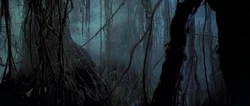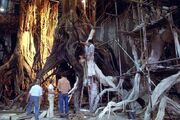| | |
The gnarltree was a type of tree that grew on Dagobah,[2] a planet of the Outer Rim Territories.[3] They grew best in swampy terrains and had large, twisted roots.[2] Dagobah pythons were commonly found amongst them.[4] Bogwings made their homes in the trees, and dragonsnakes and scrange hid amongst gnarltree roots.[5]

A grove of gnarltrees
When Jedi Grand Master Yoda had to build a more permanent home during his exile on Dagobah, he chose the knoll at the base of a great gnarltree, beside a murky lagoon, as the location of his new hut. He also crafted wattles from gnarltree roots to use as some of his construction material.[3][1]
Gnarltrees began life as pale, slender shoots, and then grew to such sizes that the roots fashioned themselves into living caves.[6] Knobby white spiders also grew into the trees.[7]
Behind the scenes[]

The gnarltrees were built from wire mesh and plaster.
The gnarltrees first appeared in Star Wars: Episode V The Empire Strikes Back, the second installment in the original trilogy of the Star Warssaga. The earliest version of what would become the gnarltrees was drawn by conceptual artist Ralph McQuarrie, who drew inspiration from the giant banyan trees, which are common in swamps of the real world.[8]
When production designer Norman Reynolds was tasked with creating those trees for the Dagobah forest set, he decided to base them on the ones found in the swamps of Nigeria instead. Reynolds began the trees with tubular steel skeletons, which were then shaped by using wire mesh and textured with plaster. The finished trees stood forty feet high, and were up to ten feet in circumference. Each prop was treated as a separate set in itself, and Reynolds made sure to imagine how each individual tree would have been altered after millennia of standing bare in the boggy environment of Dagobah.[8]
Appearances[]
Non-canon appearances[]
Sources[]
- Journey Through Space (First identified as gnarltree)
- Ultimate Star Wars
 Star Wars: Build the Millennium Falcon 20 (Guide to the Galaxy: Dagobah – The Cave of Evil)
Star Wars: Build the Millennium Falcon 20 (Guide to the Galaxy: Dagobah – The Cave of Evil)- Star Wars: Absolutely Everything You Need to Know
- Star Wars: Complete Locations
- Star Wars: The Visual Encyclopedia
- Star Wars: Geektionary: The Galaxy from A - Z
- Star Wars: Alien Archive
- Star Wars: Creatures Big & Small (Picture only)
 Disney Gallery: The Mandalorian — "Legacy"
Disney Gallery: The Mandalorian — "Legacy"- Star Wars 100 Objects
 A New Star Wars Legacy | Ahsoka | Disney+ on the official Star Wars YouTube channel (backup link)
A New Star Wars Legacy | Ahsoka | Disney+ on the official Star Wars YouTube channel (backup link) Cave of Evil in the Databank (backup link)
Cave of Evil in the Databank (backup link) Yoda in the Databank (backup link) (Picture only)
Yoda in the Databank (backup link) (Picture only) Yoda's Hut in the Databank (backup link)
Yoda's Hut in the Databank (backup link)
Notes and references[]
- ↑ 1.0 1.1 Star Wars: Episode V The Empire Strikes Back
- ↑ 2.0 2.1 2.2 2.3 2.4 2.5 Journey Through Space
- ↑ 3.0 3.1 Ultimate Star Wars
- ↑ Star Wars: Absolutely Everything You Need to Know
- ↑ Star Wars: The Visual Encyclopedia
- ↑ Star Wars: Complete Locations
- ↑
 Star Wars: Build the Millennium Falcon 20 (Guide to the Galaxy: Dagobah: The Cave of Evil)
Star Wars: Build the Millennium Falcon 20 (Guide to the Galaxy: Dagobah: The Cave of Evil)
- ↑ 8.0 8.1 The Art of Star Wars Episode V: The Empire Strikes Back

